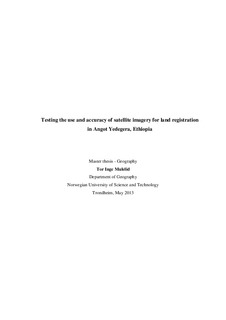| dc.description.abstract | Aim: The aim of this thesis was to study the suitability of using satellite imagery for land registration in Ethiopia. The primary focus was to investigate whether the accuracy of the derived coordinates from a WorldView-1 satellite image met the 1m requirement for rual cadastral mapping in Ethiopia. Another aim was to examine whether different border types could affect the accuracy. A final aim was to investigate the relationship between slope and the accuracy of the derived coordinates, to examine whether there was a correlation between the two.
Methods: A number of 42 Ground Control Points (GCPs) were surveyed for the orthorectification of the satellite image. Static surveying of second order points was conducted prior to the Real-Time Kinematic Global Positioning System (RTK GPS) surveying. A number of 210 parcel corners in Angot Yedegera, Ethiopia, were surveyed, using RTK GPS. These RTK GPS data served as the basis for comparison with the coordinates derived from the satellite image. Statistical analysis of the discrepancies was performed by analyzing values of central tendency and dispersion. In addition, outlier tests were conducted using boxplot and percentile values, as well as a Moran I autocorrelation test. A Pearson r correlation test was performed, between slope and the accuracy of the derived coordinates.
Results: 46.4 % of the coordinate values derived from the satellite image had discrepancies below the 1m requirement. The median of the discrepancies was 1.088m. Further, the 75th percentile was 2.386m, and the maximum deviation was 10.103m. It was found that the deviations varied according to different border types, both concerning central tendency and dispersion. The median for the border types ‘fence’, ‘pasture land’ and ‘parcel’ was below the 1m requirement, whereas the other border types had medians varying from 1.777m to 2.367m. The correlation test indicated that slope was not related to the accuracy achieved (Pearson r = 0.029).
Conclusion: It was found that the coordinates derived from the WorldView-1 satellite image do not meet the requirement of 1m accuracy. It was also found that different border types have a large influence on the accuracy achieved. The border types ‘fence’, ‘pasture land’ and ‘parcel’ achieved the highest accuracy, while the border types ‘path’, ‘forest’ and ‘diffuse’ achieved the lowest accuracy. Slope was not proved to affect the accuracy of the coordinates in either positive or negative extent. | nb_NO |
